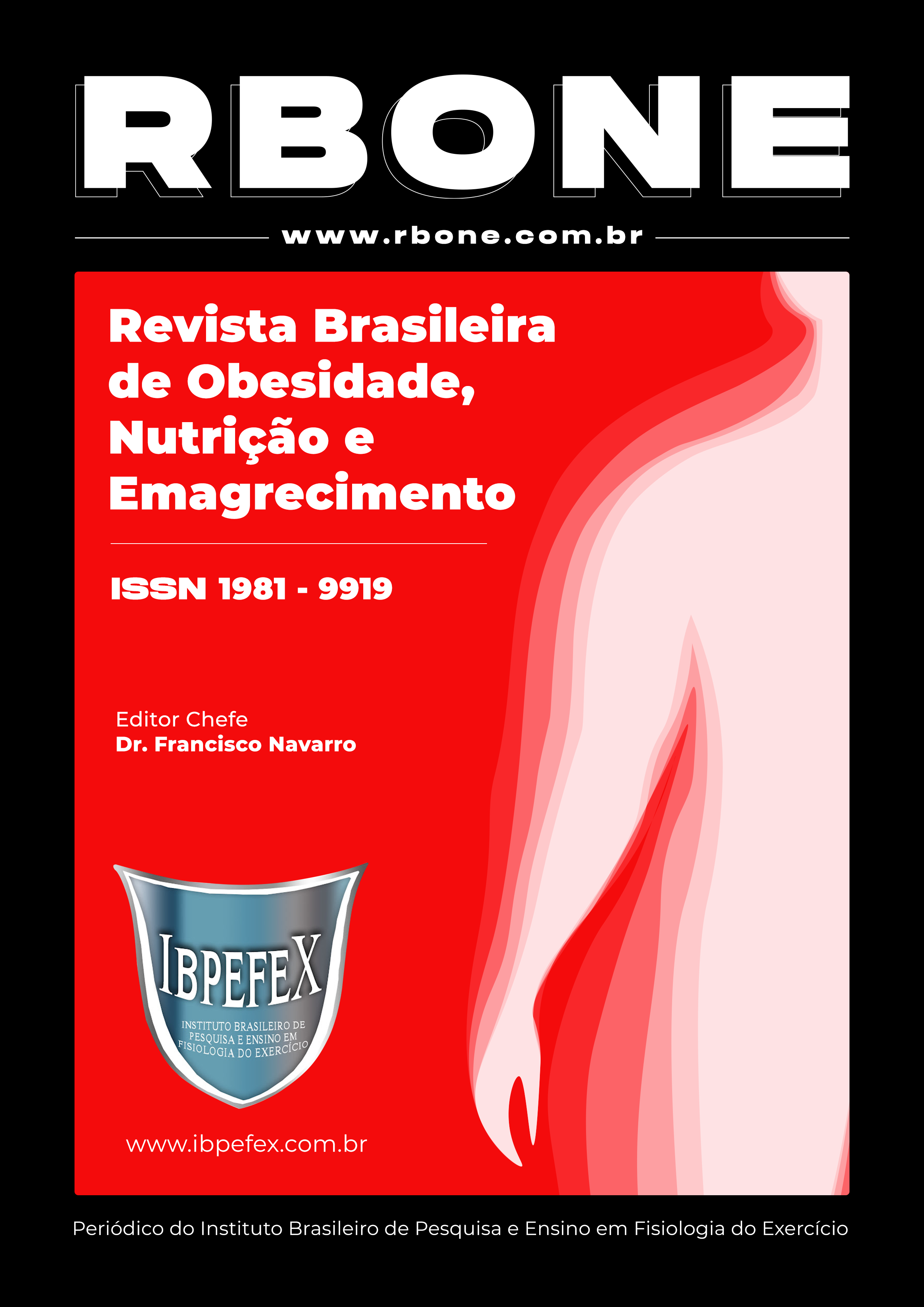Orthorexia Nervosa in participants of physical exercise at gyms in Vitória de Santo Antão-PE
Abstract
Introduction: Ortorexia Nervosa (ON) is an eating disorder related to healthy treatment, which can lead to physical, psychological, and social changes. Although physical exercise is directly related to health, it can have a negative influence on eating behavior, practical devices can be used to develop a healthy diet. Objective: To analyze the relationship between the practice of physical exercise and the risk of developing ON in gyms in Vitória de Santo Antão-PE. Materials and methods: Cross-sectional study of analytical capacity in three universities in the city of Vitória de Santo Antão-PE. The main behaviors were used: ORTO-15 to identify the risk of ON; Food Frequency Questionnaire for analysis of food consumption; IPAQ to classify the level of physical activity. Nutritional status was assessed using body mass and fat index. Results: The sample consisted of 1007.5, of both sexes, with a mean age of 27.6 ± 7 years. Of these, 82% were classified as very active and 18% as active. According to the results of ORTO-15, 92% of the sample was positive for ON. There was no statistically significant difference between ON and sex, age, fat percentage, physical activity level, or food consumption. Conclusion: The ORTO-15 results indicate an upward trend towards the development of ON in the physical activity study group but independent of the scientists' level.
References
-American Dietetic Association. Position of the American Dietetic Association: Nutrition intervention in the treatment of anorexia nervosa, bulimia nervosa, and other eating disorders. Journal of the American Dietetic Association. Vol. 106. Num. 12. 2006. p. 2073-2082.
-Barthels, F.; Meyer, F.; Huber, T.; Pietrowsky, R. Orthorexic eating behaviour as a coping strategy in patients with anorexia nervosa. Eating and Weight Disorders-Studies on Anorexia, Bulimia and Obesity, Milano. Vol. 22. Num. 2. 2017. p. 269-276.
-Betina, J.A. Ortorexia o la obsesión por la dieta saludable. Archivos latinoamericanos de nutrición. Vol. 57. Num. 4. 2007.
-Blair, S.N.; Morris, J.N. Healthy Hearts and the universal benefits of being physically active: physical activity and health. Annals of epidemiology. Vol. 19. Num 4. 2009. p. 253-256.
-Bratman, S. Orthorexia vs. theories of healthy eating. Eating and weight disorders-studies on anorexia, Bulimia and Obesity. Vol. 22. Num. 3. 2017. p. 381-385.
-Donini, L.M.; Marsili, D.; Graziani, M.P.; Cannella, C. Orthorexia nervosa: a preliminary study with a proposal for diagnosis and an attempt to measure the dimension of the phenomenon. Eating and Weight Disorders-Studies on Anorexia, Bulimia and Obesity. Vol. 9. Num. 2. 2004. p. 151-157.
-Dunn, T.M. Bratman, S. On orthorexia nervosa: A review of the literature and proposed diagnostic criteria. Eating behaviors. Vol. 21. 2016. p. 11-17.
-Hawley, J.A.; Holloszy, J.O. Exercise: it's the real thing!. Nutrition reviews. Vol. 67. Num. 3. 2009. p. 172-178.
-Lacerda, T.O. Uma aproximação estética ao corpo desportivo. Revista Portuguesa de Ciências do Desporto. Vol. 7. Num. 3. 2007. p. 393-398.
-Lorenzon, L.F.L.; Minossi, P.B.P.; Pegolo, G.E. Ortorexia nervosa e imagem corporal em adolescentes e adultos. Jornal Brasileiro de Psiquiatria. Vol. 69. 2020. p. 117-125.
-Malmborg, J.; Bremander, A.; Olsson, M.C.; Bergman, S. Health status, physical activity, and orthorexia nervosa: A comparison between exercise science students and business students. Appetite. Vol. 109. 2017. p.137-143.
-Martins, M.C.T.; Alvarenga, M.D.S.; Vargas, S.V.A.; Sato, K.S.C.D.J.; Scagliusi, F.B. Ortorexia nervosa: reflexões sobre um novo conceito. Revista de nutrição. Vol. 24. 2011. p.345-357.
-Petrie, T. A.; Greenleaf, C.; Reel, J.; Carter, J. Personality and psychological factors as predictors of disordered eating among female collegiate athletes. Eating Disorders. Vol. 17. Num.4. 2009. p.302-321.
-Pontes, J.B.; Montagner, M.I.; Montagner, M.A. Ortorexia nervosa: adaptação cultural do orto-15. DEMETRA. Vol. 9. Num. 2. 2014. p. 533-548.
-Segura-García, C.; Papaianni, M. C.; Caglioti, F.; Procopio, L.; Nisticò, C.G.; Bombardiere, L.; Capranica, L. Orthorexia nervosa: a frequent eating disordered behavior in athletes. Eating and Weight Disorders-Studies on Anorexia, Bulimia and Obesity. Vol. 17. Num. 4. 2012. p. e226-e233.
-Skemp, K.M.; Mikat, R.P.; Schenck, K.P.; Kramer, N.A. Muscle dysmorphia: risk may be influenced by goals of the weightlifter. The Journal of Strength & Conditioning Research. Vol. 27. Num. 9. 2013. p. 2427-2432.
-Wen, C. P.; Wai, J. P. M.; Tsai, M. K.; Yang, Y. C.; Cheng, T. Y. D.; Lee, M. C.; Wu, X. Minimum amount of physical activity for reduced mortality and extended life expectancy: a prospective cohort study. The lancet. Vol. 378. Num. 9798. 2011. p.1244-1253.
Copyright (c) 2022 Jacielly Roberta Heráclio da Silva, Vitor Coêlho Silva Brandão, Wanessa de Souza Xavier, Raquel Araújo de Santana, Carmem Lygia Burgos Ambrósio

This work is licensed under a Creative Commons Attribution-NonCommercial 4.0 International License.
Authors who publish in this journal agree to the following terms:
- Authors retain the copyright and grant the journal the right of first publication, with work simultaneously licensed under the Creative Commons Attribution License BY-NC which allows the sharing of the work with acknowledgment of the authorship of the work and initial publication in this journal.
- Authors are authorized to enter into additional contracts separately for non-exclusive distribution of the version of the work published in this journal (eg, publishing in institutional repository or book chapter), with acknowledgment of authorship and initial publication in this journal.
- Authors are allowed and encouraged to post and distribute their work online (eg, in institutional repositories or on their personal page) at any point before or during the editorial process, as this can bring about productive change as well as increase impact and impact. citation of published work (See The Effect of Free Access).






